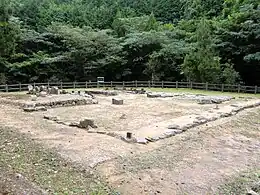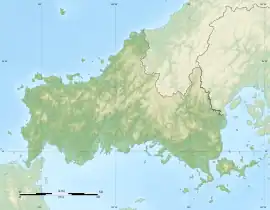| UNESCO World Heritage Site | |
|---|---|
 Ohitayama Tatara Ironworks | |
| Location | Hagi, Yamaguchi, Japan |
| Part of | Sites of Japan's Meiji Industrial Revolution: Iron and Steel, Shipbuilding and Coal Mining |
| Criteria | Cultural: (ii), (iv) |
| Reference | 1484 |
| Inscription | 2015 (39th Session) |
| Coordinates | 34°30′21.6″N 131°32′17.7″E / 34.506000°N 131.538250°E |
 Location of Ohitayama Tatara Iron Works in Yamaguchi Prefecture  Ohitayama Tatara Iron Works (Japan) | |
The Ohitayama Tatara Ironworks (大板山たたら製鉄遺跡, Ōitayama tatara seitetsu iseki) was a premodern steelworks for the production of tatara steel located in the Shibuki neighborhood of the town of Hagi, Yamaguchi Prefecture in the San'yō region of Japan. The site was designated a National Historic Site of Japan in 2012.[1]
History
Tatara (鑪) is a traditional Japanese method of processing iron into steel, which was typically use for making Japanese swords.[2] The process and name first appear in the ancient Kojiki and Nihon Shoki texts from the Nara period. The process is believed to have originated in the Kingdom of Kibi around the middle of the sixth century, spread to various places in Japan. A low box-shaped furnace containing a clay tub is constructed and heated with charcoal until the correct temperature is reached. It is then filled with alternating layers of ironsand and charcoal over a 72-hour period, with the entire process taking up to a week. Once the iron has converted to steel, the clay vessel is broken and the steel bloom removed. Typically ten tons of iron sand yield 2.5 tones of tamahagane, or raw steel. This smelting process thus differs considerbly from that of the modern mass production of steel, and also differs from contemporary Chinese and Korean methods.[3][4][5][6] In the Kamakura period and Muromachi period, furnaces increased in size to produce more steel of higher quality, with underground tunnels to more evenly distribute heat and reduce humidity. In the Edo Period, foot-operated blowers blow a large amount of air into the furnace to increase the temperature were introduced. However, following the introduction of Western technologies after the Meiji restoration, the traditional furnaces were no longer economically viable, and soon disappeared.
The Ohitayama Tatara Ironworks ruins are located in the upper reaches of the Yamaguchi River, a tributary of the Ōi River. It operated intermittently during the Bakumatsu period and was the largest metallurgical site in Yamaguchi Prefecture. The iron produced here was used in the construction of Western-style warships, making it a unique example in which Japan's unique iron-making technology was used in Western-style shipbuilding. The site is half submerged by a dam; however, the main part of the ironworks survived in the northern half of the site and was excavated from 1900 to 1996.[7] The ironworks used iron sand and charcoal from the nearby Chugoku Mountains as raw materials. It was in operation for three periods:
- Eight years in the Horeki period (1751-1764)
- Ten years in the Bunka and Bunsei periods (1812-1822)
- Twelve years in the Bakumatsu period (1855-1867)
Iron from this location was used in the Heishin Maru, the first Western-style warship of the Chōshū navy, which was built at the nearby Ebisugahana Shipyard.[7]
The site is about 30 minutes by car from Higashi-Hagi Station on the JR West San'in Main Line.[7][
Gallery
 Panorama
Panorama Foundations of furnace
Foundations of furnace Iron sand washing place
Iron sand washing place Iron pond
Iron pond Foundation of blacksmith hut
Foundation of blacksmith hut
See also
References
- Cullen, Louis M. (15 May 2003). A history of Japan 1582-1941: internal and external worlds (2003 ed.). Cambridge University Press. ISBN 0-521-52918-2. - Total pages: 357
- Jansen, Marius B.; Whitney Hall, John. The Cambridge History of Japan: The nineteenth century (1989 ed.). Cambridge University Press. ISBN 0-521-22356-3. - Total pages: 886
- Thomas Carlyle Smith (1955). Political change and industrial development in Japan: government enterprise, 1868-1880 (1955 ed.). Stanford University Press. ISBN 0-8047-0469-4. - Total pages: 126
Footnotes
- ↑ "大板山たたら製鉄遺跡" (in Japanese). Agency for Cultural Affairs. Retrieved August 20, 2021.
- ↑ https://www.jsme.or.jp/tsd/ICBTT/conference02/TatsuoINOUE.html "Science of Tatara and Japanese Sword - Traditional Technology viewed from Modern Science" by Tatsuo INOUE
- ↑ History of Iron and Steel Making Technology in Japan ーMainly on the smelting of iron sand by Tataraー. Mitsuru Tate (2005). Tetsu-to-Hagane Vol. 91. The Iron and Steel Institute of Japan.
- ↑ たたらの歴史 たたら製鉄の進歩 (Progress of Tatara Iron Making). Yasugi City
- ↑ たたら」の発祥と発展 (Changes in Japanese Tatara Iron Making Technology). Yasugi City
- ↑ たたら製鉄の歴史と仕組み. Nagoya Japanese Sword Museum Nagoya Touken World
- 1 2 3 Isomura, Yukio; Sakai, Hideya (2012). (国指定史跡事典) National Historic Site Encyclopedia. 学生社. ISBN 4311750404.(in Japanese)